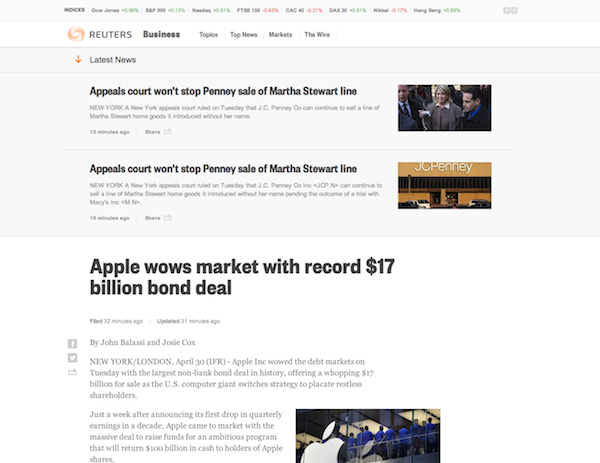 Reuters, as a wire service, has the concept of a minute-by-minute stream of news deep in its DNA. So it’s natural that its digital presence would echo that — a flowing river of information, where moving from story to story feels unencumbered.
Reuters, as a wire service, has the concept of a minute-by-minute stream of news deep in its DNA. So it’s natural that its digital presence would echo that — a flowing river of information, where moving from story to story feels unencumbered.
Yesterday Reuters unveiled a preview site for the future look and design of Reuters.com; it had given a sneak peek earlier. It’s a river-of-news type of approach that mirrors the flow of data on one of Reuters terminals, but has also become increasingly popular in the era of social media. Go to an article page and you find that you’re actually placed in the middle of a larger stream of content — scroll up or down and you’ll find your story’s text actually lives in a bifurcated version of the Reuters front page. If every page is your homepage, why not treat them all like one?
The team responsible for the new site and apps sees the project as less of a redesign and more of a rebuild: Instead of adding new flooring and fixtures, they’ve taken the house down to the foundation. (See below for more.) “This goes back to the history of Reuters. This news organizations has access to so much information being delivered in real time,” said Jim Roberts, executive editor for Reuters Digital (and until recently of The New York Times). The goal of the new digital products is to merge the worlds of traditional newsgathering and social media: “I’m also a fan of what social media is doing to conventional media to have the ability to smartly inform people in real time about the information we are creating with our 2,800 journalists.”
The stream approach has become somewhat fashionable in the world of news, said Daniele Codega, design director for Reuters Digital, partially because audiences (and publishers too) no longer have a fear of scrolling. (Some, like Quartz, have built an entire navigation hierarchy around scrolling rather than clicking.) “We have a ton of content coming through at Thomson Reuters in general,” said Codega. “It’s truly real time, and by its nature it’s different types of news in 15 different content types, from articles to slideshows to liveblogs, tweets, and videos.”
In an era when many newspapers and magazines are using typography and layout to make their apps look like their print product, Reuters — with no print edition to ape — is instead making its website look a lot like its new apps, building a consistent experience across platforms. (Also of a piece here is today’s redesign of The New York Times’ mobile site, which looks an awful lot like the Times’ mobile apps.) In Reuters’ new apps, stories open and close within the flow of news, and gesturing up or down navigates through to other stories within a topic area. On the web, a bit of JavaScript makes the loading of separate pages look a bit more seamless, using loading indicators and rapid scrolls between articles to further break the click-to-load metaphor.
The preview version of Reuters.com retains many of the expected features of any news site, including a front page that gives prominent placement to timely stories, photos, and videos. While the navigation bar offers basic directions to topics, top news, markets, and the wire, the bulk of the homepage eschews modular front page design — headings for “U.S. News,” “Sports,” “Multimedia,” and the like — in favor of a feed of news and tweets that are happening right now. Articles opening within the stream keeps readers surrounded on all sides by news. In other words, Reuters has been Twitter-ized.
Alex Leo, head of product for Reuters.com, said the larger theme of the new digital offerings is to create interconnected, contextual streams of information. “We wanted to create an experience for users that would give them the right amount of breadth and knowledge that they need from Reuters,” Leo said. In the new river of news, stories are surrounded by similarly related content. If you’re reading a story about Jason Collins becoming the first openly gay NBA player, you might see articles about basketball, gay rights, or sports. It’s similar for other stories, so with Pfizer, you’ll get drug manufacturers, and the pharmaceuticals industry. Context, in this case, cuts across different dimensions, Leo said, not just background on a story but also information on a particular industry, a region of the world, or people and places associated with a topic. Reuters is able to manage this through a deep tagging system, which means stories can pop up in different areas.
Redesigning a news websites is an exercise in sacrifice and testing assumptions, because no matter how well you optimize a page it’s likely readers won’t get exposed to all of your work. Designers and editors have to deal in tradeoffs: How much room should you dedicate to headlines vs. story excerpts? How big can you make photos at the expense of text? What tools are readers really looking for on the page, and what are we keeping for our own vanity?

On the new Reuters.com, articles will be more or less elements on the page designed to point readers in a direction they may have some interest in. If you wound up on Reuters.com because you clicked on a Apple story from Twitter, they want to offer up as much related fare as possible. Because if you came to read a technology story, it’s likely you’ll have some interest in similarly related tech content. By mingling individual articles among other content, Reuters wants to prevent them from becoming a dead-end street. As Leo put it, “We don’t want readers to run around the site to fetch stories.”
It’s a move that recognizes the ascendance of individual articles over homepages, largely powered by social media. Leo said Reuters is taking some cues from services like Twitter and Tumblr that “display news and create engagement around the news.” But the emphasis on article pages also makes sense for a news company that, while having a long history and significant news-gathering resources, may lack the name recognition with consumers that other news sites do. If you’re someone familiar with a Thomson Reuters finance or legal products, you probably associate the name with news. By making a social-friendly site, Reuters wants to broaden that association to a larger audience.
Roberts said news sites homepages are still a powerful driver of traffic, but the tide is shifting in another direction. “The days where you could drive big portion of audience to any single page? That’s pretty much done,” he said. The media have to be willing to adapt to changing times, Roberts said, and that means having a highly adaptable website and apps. “This is just the beginning,” Roberts said. Expect the new Reuters site to regularly tweak features and roll out new tools, he said.
Curious about the technology behind the new Reuters site? Reuters.com technology editor Paul Smalera, who was a project manager on the site, tweeted out a few of the details yesterday:
So much cool tech behind preview.reuters.com, I have to share: 1. RESTful API outputting assets as JSON (modern!!)
— Paul Smalera (@smalera) April 30, 2013
2. One custom built CMS controls API and all client-facing apps. (take that, haters!)
— Paul Smalera (@smalera) April 30, 2013
3. Hosted on Amazon cloud, no more big iron datacenter for Reuters News.
— Paul Smalera (@smalera) April 30, 2013
4. Much of back-end built in Python and associated technologies. Again, modern! Webby!
— Paul Smalera (@smalera) April 30, 2013
5. Best tech of all: Amazingly dedicated team of people behind it, trying our best to get it right. Onwards to features, iterations & more!
— Paul Smalera (@smalera) April 30, 2013
Oh yeah, we used MongoDB too.
— Paul Smalera (@smalera) April 30, 2013